
St. Martin's Cathedral, Utrecht, or Dom Church, is a Gothic church dedicated to Saint Martin of Tours, which was the cathedral of the Diocese of Utrecht during the Middle Ages. It is the country's only pre-Reformation cathedral, but has been a Protestant church since 1580.

St. Stephen's Cathedral is a Roman Catholic church in Vienna, Austria, and the mother church of the Archdiocese of Vienna. It is the seat of the Archbishop of Vienna, Christoph Schönborn.
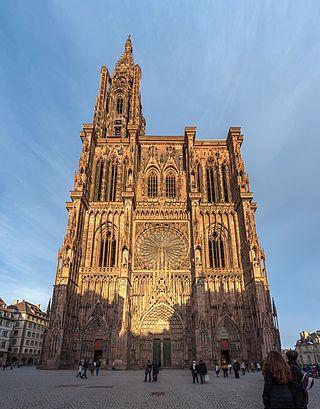
Strasbourg Cathedral or the Cathedral of Our Lady of Strasbourg, also known as Strasbourg Minster, is a Catholic cathedral in Strasbourg, Alsace, France. Although considerable parts of it are still in Romanesque architecture, it is widely considered to be among the finest examples of Rayonnant Gothic architecture. Architect Erwin von Steinbach is credited for major contributions from 1277 to his death in 1318, and beyond through his son Johannes von Steinbach, and his grandson Gerlach von Steinbach, who succeeded him as chief architects. The Steinbachs’ plans for the completion of the cathedral were not followed through by the chief architects who took over after them, and instead of the originally envisioned two spires, a single, octagonal tower with an elongated, octagonal crowning was built on the northern side of the west facade by master Ulrich Ensingen and his successor, Johannes Hültz. The construction of the cathedral, which had started in the year 1015 and had been relaunched in 1190, was finished in 1439.

Mainz Cathedral or St. Martin's Cathedral is located near the historical center and pedestrianized market square of the city of Mainz, Germany. This 1000-year-old Roman Catholic cathedral is the site of the episcopal see of the Bishop of Mainz.
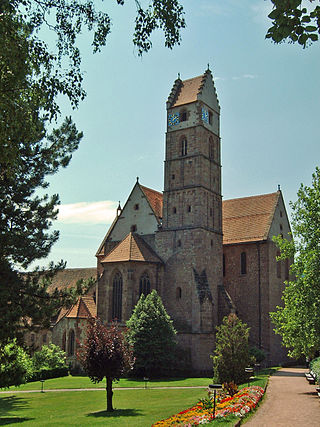
Alpirsbach Abbey is a former Benedictine monastery and later Protestant seminary located at Alpirsbach in Baden-Württemberg, Germany. The monastery was established in the late 11th century and possessed considerable freedoms for an ecclesiastical property at that time, but in the 13th century it became a de facto possession of the Dukes of Teck and then the County of Württemberg. In the 15th century, the monastery enjoyed economic prosperity and was expanded but was dissolved with the conversion of the by-then Duchy of Württemberg to Lutheranism in the 16th century. The monastery became a seminary and boarding school until the 17th century and was physically reduced over the 19th century by land sales and demolition. Over the second half of the 20th century, the monastery was turned into a cultural fixture with annual concerts of Classical music and a museum of its history.

St. James' Church is a former collegiate church in Antwerp, Belgium. The church is built on the site of a hostel for pilgrims to Santiago de Compostela. The present building is the work of the Waghemakere family and Rombout Keldermans, in Brabantine Gothic style. The church contains the grave of Peter Paul Rubens in the eastern chapel.

St Peter's Cathedral is a Roman Catholic church and former cathedral in Worms, southern Germany.

Speyer Cathedral, officially the Imperial Cathedral Basilica of the Assumption and St Stephen, in Latin: Domus sanctae Mariae Spirae in Speyer, Germany, is the seat of the Roman Catholic Bishop of Speyer and is suffragan to the Roman Catholic Archdiocese of Bamberg. The cathedral, which is dedicated to St. Mary, patron saint of Speyer and St. Stephen is generally known as the Kaiserdom zu Speyer. Pope Pius XI raised Speyer Cathedral to the rank of a minor basilica of the Roman Catholic Church in 1925.
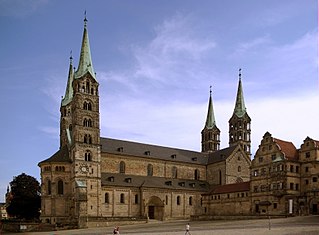
Bamberg Cathedral is a church in Bamberg, Germany, completed in the 13th century. The cathedral is under the administration of the Archdiocese of Bamberg and is the seat of its archbishop. Since 1993, the cathedral has been part of the UNESCO World Heritage Site "Town of Bamberg".
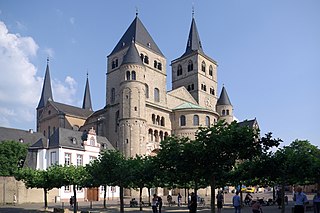
The High Cathedral of Saint Peter in Trier, or Trier Cathedral, is a Roman Catholic cathedral in Trier, Rhineland-Palatinate, Germany. It is the oldest cathedral in Germany and the largest religious structure in Trier, notable for its long life span and grand design. The central part of the nave was built of Roman brick in the early fourth century, resulting in a cathedral that was added onto gradually in different eras. The imposing Romanesque westwork, with four towers and an additional apse, has been copied repeatedly. The Trier Cathedral Treasury contains an important collection of Christian art. In 1986 the church was listed as a UNESCO World Heritage Site, as part of the Roman Monuments, Cathedral of St. Peter and Church of Our Lady in Trier.

Naumburg Cathedral, located in Naumburg, Germany, is the former cathedral of the Bishopric of Naumburg-Zeitz. The church building, most of which dates back to the 13th century, is a renowned landmark of the German late Romanesque and was recognised as a UNESCO World Heritage Site in 2018. The west choir with the famous donor portrait statues of the twelve cathedral founders (Stifterfiguren) and the Lettner, works of the Naumburg Master, is one of the most significant early Gothic monuments.
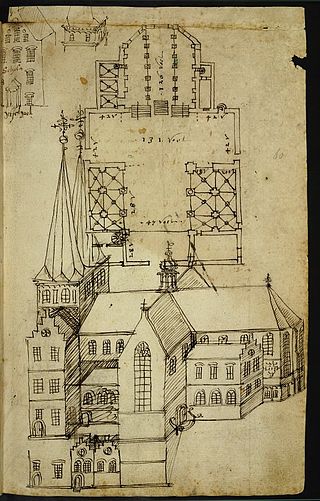
The Sint-Salvator church was one of five Catholic Church collegiate churches in Utrecht, Netherlands, before the Protestant Reformation. The others were St. Martin's Cathedral, St. Peter's Church, St. John's church and St. Mary's church. The church building was situated on the present-day Domplein and was demolished during the Protestant Reformation, after the 1587 outlawing of Catholicism in the Dutch Republic.
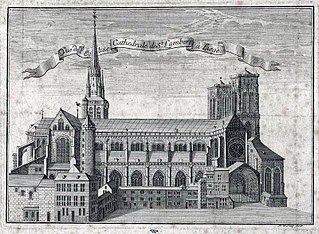
St. Lambert's Cathedral was the Roman Catholic cathedral of Liège, modern-day Belgium, until 1794, when its destruction began. This enormous Gothic cathedral, dedicated to Saint Lambert of Maastricht, occupied the site of the present Place Saint-Lambert in the centre of Liège.
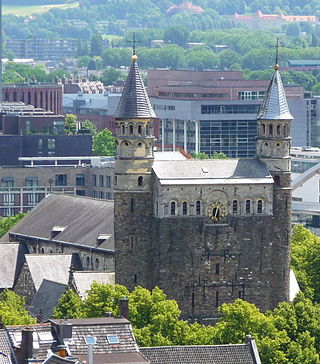
The Basilica of Our Lady is a Romanesque church in the historic center of Maastricht, Netherlands. The church is dedicated to Our Lady of the Assumption and is a Roman Catholic parish church in the Diocese of Roermond. The church is often referred to as the Star of the Sea, after the church's main devotion, Our Lady, Star of the Sea.
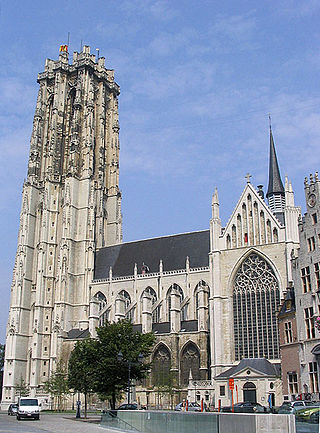
Brabantine Gothic, occasionally called Brabantian Gothic, is a significant variant of Gothic architecture that is typical for the Low Countries. It surfaced in the first half of the 14th century at St. Rumbold's Cathedral in the city of Mechelen.
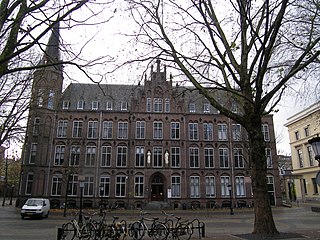
The Utrechts Conservatorium is a Conservatory of Music in Utrecht, Netherlands and part of the Utrecht School of the Arts (HKU). The conservatory opened in 1875 and is one of the eldest professional musical education institutes of the Netherlands. Since 1971, the conservatory is located in the former concert hall Gebouw voor Kunsten en Wetenschappen and in the former hospital St. Joannes de Deo, both on the same street. Apart from these two buildings, the Nederlandse Beiaardschool, located in Amersfoort, is also part of the school. The Utrechts Conservatorium merged in 1987 with the Carillon School and the Nederlands Instituut voor Kerkmuziek into the Faculty of music of the Utrecht School of the Arts.
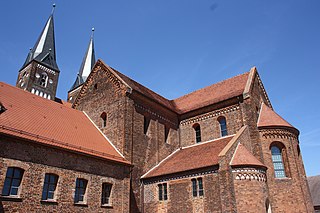
The Jerichow Monastery is a former Premonstratensian monastery located in the northern outskirts of Jerichow, near the shores of the Elbe River, in the state of Saxony-Anhalt of Germany.

St. Wenceslas Church at Zderaz is a Gothic single-nave church in Prague – New Town. It is located at the crossroad of Resslova Street and Dittrichova Street.

The Swan Brothers' House in 's-Hertogenbosch is a museum and the home of a famous medieval confraternity.

St Severus' Church in the city of Erfurt in Thuringia, Germany, is a Roman Catholic church building. It stands on the Domberg directly next to St Mary's Cathedral. As a unique architectural ensemble, both churches together form the city's landmark. Due to its unusual form, which seems to anticipate the late Gothic hall church, St Severus' Church is one of the most important Gothic buildings in Germany. The bones of the church patron Severus of Ravenna rest in an artistically very significant sarcophagus.






















